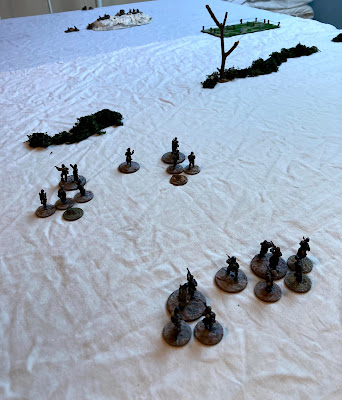Last night's game by Skype was successful. Tom and Simon signed in by Skype and we played the latest episode in the Song of Pavis campaign.
As Tom had run the Lunars in the first game of the campaign, he took the option of doing so again. This meant that for the second time he had very limited information as to what was actually going on in the scenario.
Tom's main character was the Imperial Commissioner for the Census, Jaxarte Whyded. All Tom knew was that Jaxarte had intervened when he'd seen guards at the Old Gate removing a silver amulet from a prisoner. Suspecting that otherwise the amulet would be fenced to pay the guard sergeant's gambling debts, Jaxarte had taken it into protective custody. He was just contemplating how he might establish if the prisoner had legal title to the item when his bodyguard reported trouble in the street outside their office.
Simon's Sartarite rebels, meanwhile, were determined to retrieve the amulet as it was needed to further their future plans. A small strike party, led by Vareena Stonebrow, was to assault the office. They would do this under cover of river mist blown into town by a breeze summoned by an Orlanthi priest.
The game began with Jaxarte in his office, his bodyguard Vanides on the roof checking the security position, and two Lunar peltasts in a guard post near the southeastern corner of the board.
 |
Jaxarte's office is the building on the right with a balcony.
The balcony of the two-storey house is on the left. |
The Sartarites decided to enter from two directions. Illaril Oathsworn, a very skilled archer, and leader Vareena Stonebrow would go in through the rear door of the two-storey house opposite, while the steadfast Magar Ketilsson, dashing Grann, and opportunistic Liv Vannasdottir would advance down the main avenue directly towards Jaxarte's office.
Illaril and Vareena discovered that the rear door was locked but a firm shoulder charge burst it open (the doors rules from Song of Gold and Darkness in use here).
This attracted the attention of the peltasts in the guard post and a melee soon developed around the forced door.
 |
Vareena has the advantage over the peltasts
even though Illaril has already disappeared inside.
|
Note that I prefer to use "Disadvantaged" markers rather than laying "Fallen" models down their backs.
In the end one of the peltasts suffered a gruesome kill and his mate fled the scene.
After a considerable amount of indecision on Simon's part (perhaps inevitable given the difficulty of getting a clear picture of events via Skype) Illaril would eventually end up on the balcony of the house shooting across the road outside.
In the meantime, Jaxarte had decided to leave the office with his bodyguard trailing behind him. He was quickly waylaid by Magar Ketilsson...
... who had raced on ahead of his follow rebels.
Jaxarte summoned his Lune and Vanides emerged from the office door so Magar was soon outnumbered and eventually downed by a thrust of Vanides's spear.
As Vanides prepared to loot the body (he has the Greedy special rule), the remaining Sartarites arrived. A fierce melee developed.
For a moment Jaxarte stood alone as the battle ebbed and flowed around him. Illaril chose that moment to loose an arrow from her balcony position. It found its mark in Jaxarte's breast and he fell, apparently dead.
 |
Vanides stands over the bodies of his employer
(represented by the purple heart) and Magar
Ketilsson (red disc). |
 |
More peltasts arrive - more targets for
Illaril Oathsworn |
At this point, one of the newly arrived peltasts also fell to Illari's deadly arrows. This took the Lunars to the point where the dead and fled outnumbered the living. The resulting morale tests saw a Trollkin watchman (who had done nothing so far) rout from the board and Vanidies retreat from the action.
As Vareena stood guard, Liv Vannasdottir retrieved the amulet from Jaxarte's body. So that leaves us with one win for each of the three factions in the campaign.
Using the campaign rules in SOBH I rolled to see whether the "dead" personalities were indeed deceased. Magar Ketilsson proved to be only lightly injured and will be available the next time the rebellion needs his services. Jaxarte Whyded is also recovering from his wounds. He will be at -1 on Quality rolls in the next game.
Next time the Cult of Pavis will be back in action, this time against a neutral force. Details to follow.
































